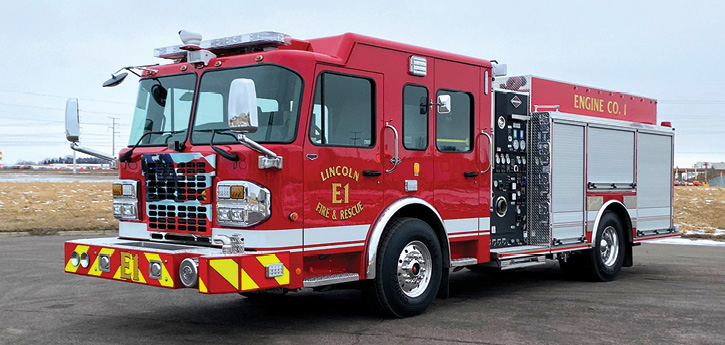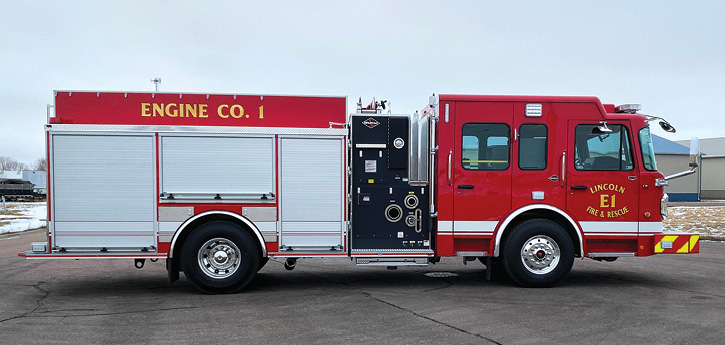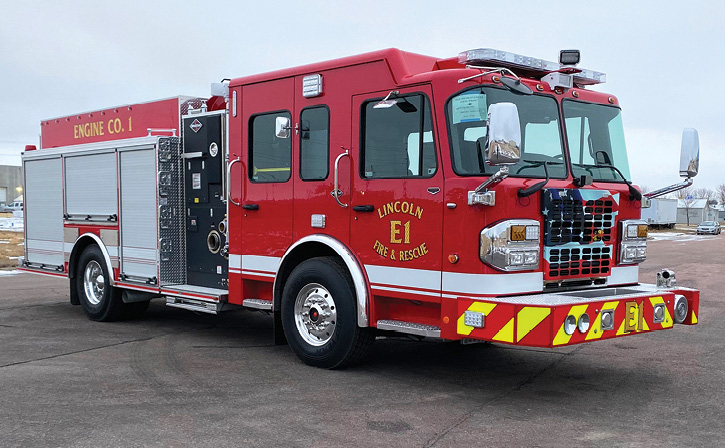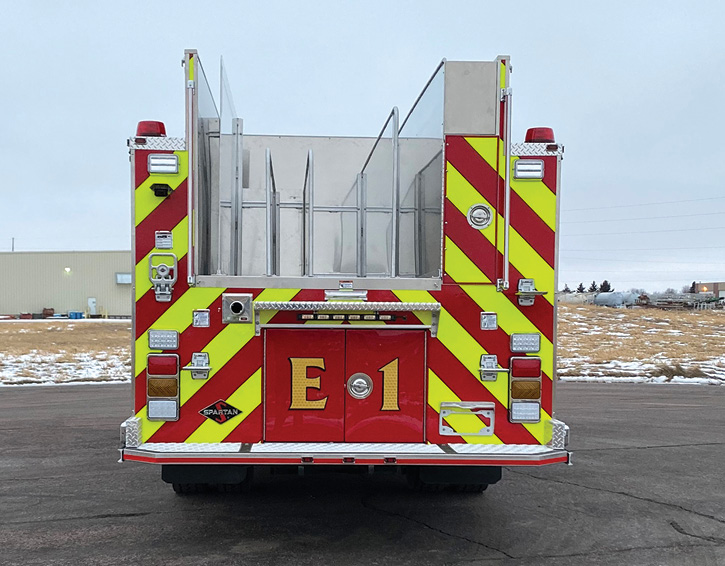
By Alan M. Petrillo
Lincoln (NE) Fire & Rescue embarked on a determined effort a few years ago to expand, improve, and modernize its fleet by purchasing five top-mount Smeal pumpers and two Smeal 105-foot aerial ladders. Last year, it expanded its fleet further with the purchase of seven Spartan ER side-mount pumpers.
CHASSIS
The pumpers are built on Spartan Metro Star EMFD chassis and cabs with seating for five firefighters and Spartan Star bodies. The cabs’ interiors have provisions for three firefighters in forward-facing H.O. Bostrom SecureALL™ self-contained breathing apparatus (SCBA) seats, with the officer in a Bostrom SecureALL seat and the driver in a nonSCBA Bostrom seat.
Related Content
- Special Delivery: Rosenbauer Builds Two Pumper-Tenders for Spokane County (WA) Fire District #3
- Special Delivery: E-ONE Delivers Two Height-Restricted Metro 100 Aerial Ladders to the Cincinnati (OH) Fire Department
- Special Delivery Archive
The pumpers with 304-inch-long bodies were built in Brandon, South Dakota, and are equipped with stainless-steel tubular body structures that improve structural stability, says Joel Konecky, account manager for Spartan Motors. The Star body pumpers feature Vibra-Torq body mount systems, which reduce vibration and provide a smoother ride, longer vehicle life, and less maintenance, which serves to minimize downtime, he points out. The exteriors of the rigs are painted with Spartan ER’s nine-step paint process, which delays corrosion, rust, and other oxidation from weather and environmental corrosives, Konecky maintains.

1 Spartan ER built seven side-mount pumpers on Spartan Metro Star EMFD chassis with 10-inch raised roofs and seating for five firefighters for Lincoln (NE) Fire & Rescue. (Photos courtesy of Feld Fire Equipment Co. Inc.)

2 The Spartan ER pumpers for Lincoln Fire & Rescue are powered by 380-hp Cummins ISL9 diesel engines and Allison 3000 EVS automatic transmissions.
Wheelbases on the side-mount pumpers are 184½ inches, overall lengths are 32 feet 10 inches, overall heights are 10 feet 5 inches, widths are 99 inches, angles of approach and departure are 8 inches, front axle gross vehicle weight ratings (GVWR) are 20,000 pounds, and the rear axle GVWRs are 27,000 pounds. The pumpers are powered by Cummins 380-horsepower (hp) ISL9 diesel engines and Allison 3000 EVS automatic transmissions.
Konecky says the pumpers “have an excellent cramp angle of 55 degrees. Drivability and rideability for the crew was very important to Lincoln, so we installed Reyco Granning independent front suspensions and Meritor parabolic rear spring suspensions.”
department
Lincoln (NE) Fire & Rescue
Strength: 300 paid firefighters, 16 stations.
Service area: The department provides fire suppression and prevention, rescue, and emergency medical services to 287,400 people in its 249-square-mile coverage area. Lincoln Fire & Rescue also is the sponsoring agency for the Nebraska Task Force One urban search and rescue team.
Other apparatus: 18 front-line and reserve engines, five aerial ladders, one heavy technical rescue, 13 medical units, one mobile air unit, one hazmat unit, one rehab unit, one dive rescue unit, one decon trailer, and one water rescue trailer.
SIDE-MOUNT PUMPER CHOICE
Kendall Warnock, Lincoln’s division chief of logistics and interim assistant chief, says until the department got the top-mount pumpers in 2018, “we were on life support with our fleet. Some of our front-line apparatus were old enough to vote, and some were old enough to drink. Then the city bought the top-mounts and last year provided emergency funds to buy the seven side-mount pumpers from Spartan ER.”
Warnock notes, “We went to a side-mount pumper style because we wanted to shorten the wheelbase and overall length of our engines. Those shorter side-mount engines also are more maneuverable than our top-mounts, and they all have independent front suspensions that give us a really good cramp angle.”
The pumpers carry Waterous CXVK 1,250-gallon-per-minute (gpm) power takeoff (PTO)-driven pumps, 500-gallon water tanks, 20-gallon foam tanks, and FoamPro 2001 foam systems, says Eric Boes of Feld Fire, who sold the vehicles to Lincoln Fire & Rescue.

3 Lincoln Fire & Rescue’s new pumpers have Waterous CXVK 1,250-gpm PTO-driven pumps, 500-gallon water tanks, 20-gallon foam tanks, and FoamPro 2001 foam systems.

4 Lighting on the Spartan ER pumpers includes Whelen LED Freedom light bars, Whelen LED warning lighting, Whelen M9 side scene lights, FRC Spectra LED 12-volt brow lights, two FRC Spectra LED telescoping lights, and Whelen LED traffic advisors.

5 An enclosed ladder tunnel on the right rear of each pumper holds a 24-foot, two-section extension ladder; a 14-foot roof ladder; a 10-foot folding attic ladder; and three pike poles.

6 One of Lincoln Fire & Rescue’s hosebeds, from left to right, is set up to hold 400 feet of 1¾-inch hose, 200 feet of 2½-inch hose, 400 feet of 2½-inch, 200 feet of 2½-inch, 200 feet of 2½-inch, and 800 feet of 5-inch LDH.
Boes says each side-mount pumper has two single-stack 1¾-inch hose speedlays of 250 feet each, a 2½-inch discharge on the front bumper with a center hose well, a hose reel with one-inch booster line in the right side dunnage area, a Task Force Tips (TFT) Hurricane 1,250-gpm deck gun with a TFT Extend-A-Gun, and TFT AX3ST-NX-RC electronic remote control valves on the 6-inch intakes on each side of the vehicle. Each rig also has a 2½-inch discharge on the left side pump panel; a 2½-inch discharge on the left rear of the rig; and a 2½-inch inlet, a 2½-inch discharge, and a 4-inch discharge on the right pump panel.
Warnock notes that each pumper has backboard storage in a compartment behind the speedlays; PAC Trac on the back of most compartments; an Audio Vox Voyager backup camera; and a 24-foot two-section extension ladder, a 14-foot roof ladder, a 10-foot folding attic ladder, and three pike poles in a tunnel on the upper right side of the pumper.
specs
Spartan ER Pumpers
- Spartan Metro Star EMFD chassis with 10-inch raised roofs and seating for five firefighters each
- Stainless steel bodies
- Cummins 380-hp ISL9 diesel engines
- Allison 3000 EVS automatic transmissions
- Waterous CXVK 1,250-gpm PTO-driven pumps
- 500-gallon water tanks
- 20-gallon foam tanks
- FoamPro 2001 foam systems
- TFT Hurricane 1,250-gpm deck guns with TFT Extend-A-Gun
The hosebed is set up to satisfy Lincoln’s particular working arrangement, Warnock says. From left to right, the hosebed holds 400 feet of 1¾-inch hose, 200 feet of 2½-inch hose, 400 feet of 2½-inch, 200 feet of 2½-inch, 200 feet of 2½-inch, and 800 feet of 5-inch large diameter hose, he says.
Lighting on the pumpers, Boes says, includes Whelen LED warning lighting, Whelen LED Freedom light bars, Whelen M9 side scene lights, FRC Spectra LED 12-volt brow lights, two FRC Spectra LED telescoping lights at the back of the cabs, and Whelen LED traffic advisors.
Warnock points out, “These seven Spartan ER side-mount pumpers have been home runs for us. The apparatus committee worked hard on the specs, hand-in-hand with our labor group and with Spartan ER, to get the vehicles that would work best for us. These pumpers have been overwhelmingly a huge hit with the firefighters in the field. We’re incredibly grateful to our mayor and city hall for allowing us to purchase these engines and serve and protect our citizens.”
ALAN M. PETRILLO is a Tucson, Arizona-based journalist, the author of three novels and five nonfiction books, and a member of the Fire Apparatus & Emergency Equipment Editorial Advisory Board. He served 22 years with the Verdoy (NY) Fire Department, including in the position of chief.

